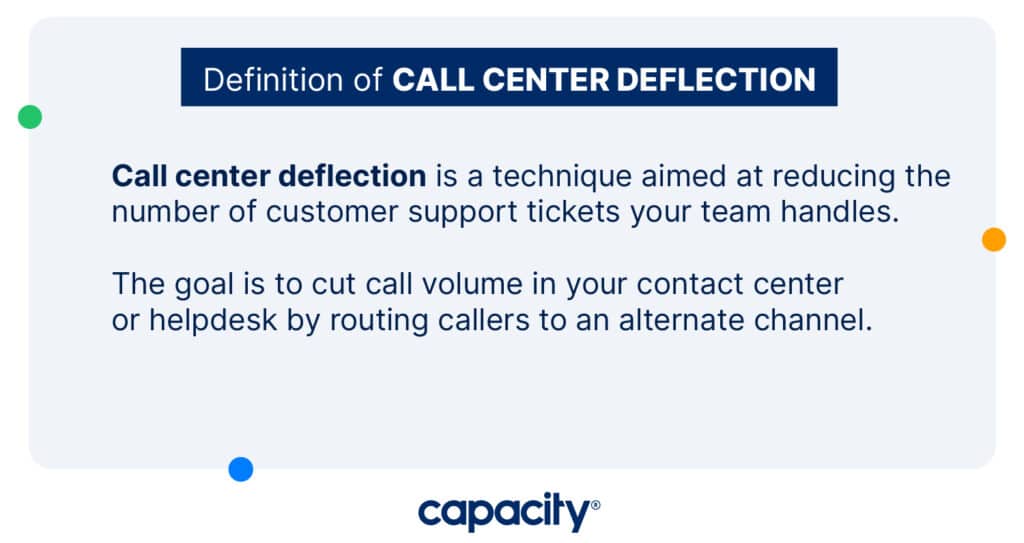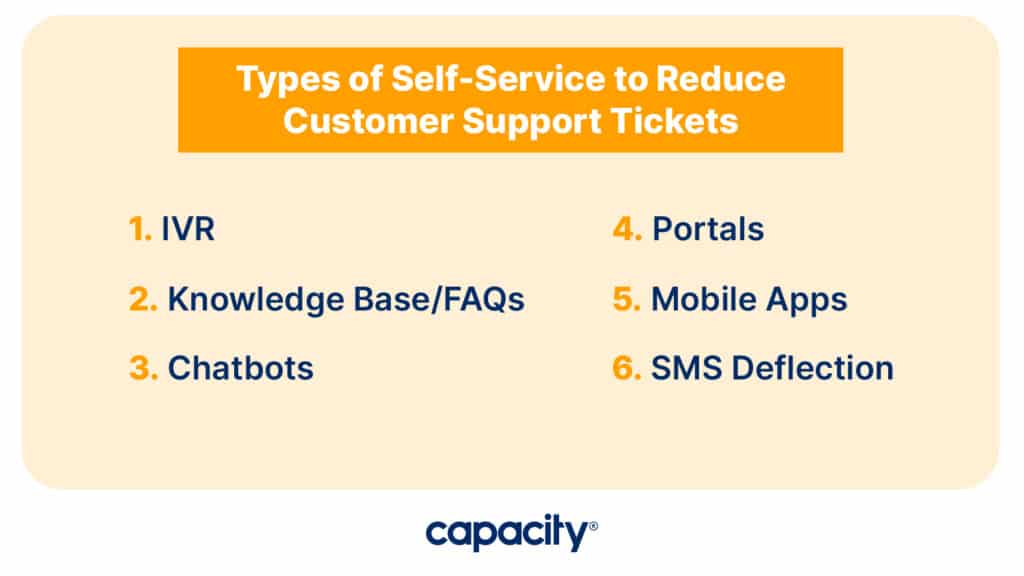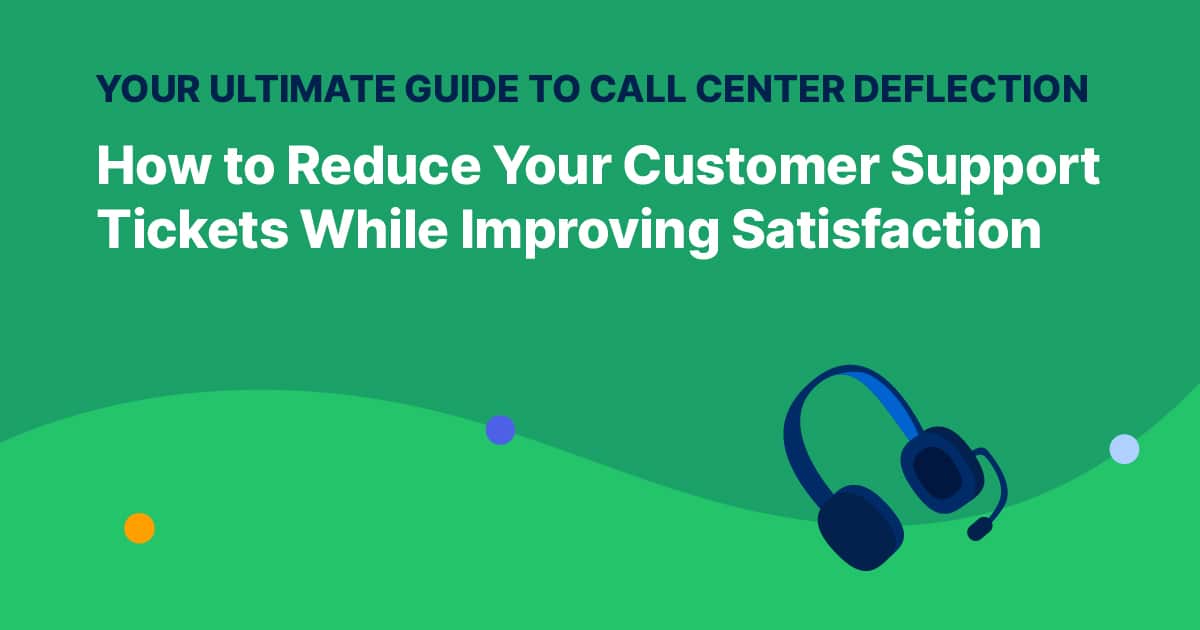Reducing customer support tickets makes both your customers and your agents happy. Customers get their questions answered faster, which boosts their satisfaction. And, agents don’t have to spend their day replying to the same, basic questions all day long, so they can be more productive and happier at work.
In this guide, we’re looking at how you can add in automation and, yes, even some AI to deflect your customer support tickets, cut down your call volume, and improve satisfaction.
What is call center deflection?

Just to make sure we’re all on the same page, let’s take a second to define what call center deflection means. To us, it refers to reducing the number of customer support tickets your team handles. It’s a technique aimed at cutting call volume in your contact center or to your helpdesk by routing callers to an alternate channel.
The point of deflection is to give customers the information they need before they reach out. This might mean offering online tutorials or FAQs, having a chatbot answer basic questions, or even adding SMS or MMS messages into your workflow (like what our sister company, Textel does!). Each of these tools lets customers quickly and easily find the answers they need. And, they can do it all without having to reach out to your support team.
How customer support tickets can use automation to help deflection
Thanks to advances in automation, CS teams have a huge range of options for deflecting calls. From automated emails to bots and SMS flows, there are tons of ways your team can use tech to improve CX while cutting call volume. (Note another less than subtle nod to Textel there.)
But AI-powered deflection isn’t just about replacing humans with robots. It’s about easing the workflow for both agents and customers. AI is a robot perched on our shoulders, not an agent with a headset. It’s here to help us focus on more important tasks and leave mundane, repetitive tasks behind. That way, agents can focus on complex interactions where their empathy and problem-solving skills can shine.
Okay, okay, you’re here to learn about the how-to’s though, right? I hear you. Customer support tickets backed by AI use natural language processing to understand what customers are saying. Then, it analyzes the data, answers the question, or routes it to the right team. This, then, cuts out the manual steps and gets customers to the right answers faster.
Even better, customer support tickets that are collected through an AI-driven helpdesk can offer automated suggestions on how to reply. And they can drum up personalized responses based on customer feedback. Plus, it can detect duplicates and prioritize tickets in the queue. Then, you can use predictive analytics to see where customers may need more help or further instructions. These features make it easier for customer support teams to quickly respond with accurate solutions. And, it means agents can shell out a better experience for customers.
To get started, try spinning up some self-service resources for your customers. And, of course, you’ll want to add consistent agent training and coaching. You may consider building out a knowledge base (psst…we have a pretty stellar one that feeds our AI-backed helpdesk. It’s cool, you should check it out here.). Then you’ll need to measure, get feedback, optimize (and rinse and repeat).
Adding self-service in your call center
Self-service is no longer a “nice-to-have” feature. It’s the ice cream to your customer’s double-scope chocolate fudge sundae; it’s foundational. According to an old study (from 2013), 70% of customers said they expect your website to include some sort of self-service application. Again, that was from 2013! Way before the pandemic. Way before remote life became just…life. And way before we all realized we’re a little socially anxious. I’d wager to say that number has only increased over the last decade.
A more recent study from Higher Logic found that 77% of customers view brands more positively if they provide a self-service option for support.
Types of self-service options
There are a bunch of self-service options your call center can use to reduce customer support tickets hitting your queues. Here are a few:

1. Interactive Voice Response (IVR) systems
You work in the support realm, so you know what an IVR is. But to level-set, IVRs are a type of automated phone (or text) system that lets contacts navigate through different options. You know, the “press 1 to hear our hours,” kind of thing. Using an IVR or an SMS IVR deflection, customers can check account balances, make payments or update their info without pulling in an agent.
2. Knowledge base or Frequently Asked Questions (FAQs)
A knowledge base or FAQs is a collection of information, typically available online, that provides answers to commonly asked questions or provides instructions on how to resolve common issues. Customers can search or browse through the knowledge base to find answers to their questions or solutions to their problems.
3. Online chat or live chat
Using a chatbot lets your customers connect in real time with a person or a bot through your website or app. Customers can ask questions, get proactive info, or resolve issues through the chat interface without picking up the phone.
4. Self-service portals
Self-service portals are web interfaces that let customers perform some action without an agent. Customers can log into the portal with unique credentials. Then, they can access self-service options like updating contact info or managing an order.
5. Mobile apps
You can create a mobile app for your customers to self-serve on their issues. Your app might provide bill payments or appointment schedulers. These take care of vital tasks without bringing in an agent.
6. Automated email or text message responses
Your center can use automated emails or texts to give customers pre-written responses to common inquiries or issues. You can also use products (like ours) to add in machine learning and NLP for personalized responses at scale.
Boosting agent training & resources to reduce customer support tickets
Sure, agent training is already on your radar. But what are you doing in those training sessions? And, how are you setting up your agents to support the tools and techniques you’re using to deflect customer support tickets and boost CSAT?
Start by training agents on your product and services. Then, make sure they know what resources are available. Give them clear instructions on when and how to pull in different deflection techniques, too.
5 training sessions to get started
Here are five training sessions to consider adding to your schedule to help deflect customer support tickets in your call center.

Session 1: Product and service training
Make sure your call center agents know the products and services offered by your company. This includes understanding the features, benefits, and limitations of each product or service. Agents should also be familiar with common issues or questions customers may have. And they should have accurate, up-to-date information to address them.
Training Time: 1 hour
Session 2: Active listening
Train your agents to actively listen to customers and understand their issues. Train agents to let your customers explain their problem, without interrupting. Then, the agent should paraphrase to confirm understanding and ask clarifying questions. Active listening helps agents identify the root cause of the issue and provide an appropriate solution, reducing the need for follow-up tickets.
Training Time: 30 minutes
Session 3: Problem-solving skills
Arm your call center agents with problem-solving techniques to effectively and efficiently resolve customer issues. This may include using structured problem-solving frameworks, decision-making tools, and critical thinking skills. Agents should be trained to analyze situations, identify options, and select the best course of action to address customer issues and minimize the need for future tickets.
Training Time: 1 hour
Session 4: Empathy and soft skills
Train your call center agents in empathy and soft skills, like effective communication, patience, and professionalism. Agents should be able to connect with customers on an emotional level, show empathy toward their concerns, and communicate politely and courteously. This can help build rapport with customers, de-escalate potentially difficult situations, and resolve issues more effectively.
Training Time: 45 minutes
Session 5: Ticket documentation
Emphasize the importance of accurate and thorough ticket documentation. Agents should be trained to document all relevant information, including the customer’s issue, the steps taken to resolve it, and any additional notes or comments. This helps ensure that the ticketing system has a comprehensive record of the customer’s issue, reducing the need for customers to submit multiple tickets for the same problem.
Training Time: 30 minutes
Bonus: Continuous Training and Development
Implement an ongoing training and development program for call center agents to continuously improve their skills and knowledge. This may include regular refresher courses, role-playing exercises, and feedback sessions. Keeping agents updated with the latest product information, customer service techniques, and industry trends can help them provide better support and reduce the number of support tickets.
Training Time: Ongoing
Automate support with Capacity. Try today for free, or request a personalized demo!





